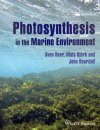By: Sven Beer(Author), Mats Björk(Author), John Beardall(Author)
208 pages, colour & b/w photos, b/w illustrations, tables
![Photosynthesis in the Marine Environment Photosynthesis in the Marine Environment]()
Click to have a closer look
About this book
Customer reviews
Related titles
About this book
"Marine photosynthesis provides for at least half of the planet's primary production and forms the basis of nearly all marine food webs..."
Photosynthesis in the Marine Environment provides a comprehensive explanation of photosynthetic processes as they relate to the special environment in which marine plants live.
The first part of Photosynthesis in the Marine Environment introduces the reader to the variety of photosynthesising organisms in marine habitats: the phytoplankton (both cyanobacteria and eukaryotes) in open waters, and macroalgae, marine angiosperms and photosymbiont-containing invertebrates in those benthic environments where there is enough light for photosynthesis to support growth. The evolutionary origins of these organisms are also considered. The special properties of seawater for sustaining primary production are then discussed, and the two main differences between terrestrial and marine environments in supporting photosynthesis and plant growth, namely irradiance and inorganic carbon, are examined.
The second part of Photosynthesis in the Marine Environment outlines the general mechanisms of photosynthesis, and then points towards the differences in light-capturing and carbon acquisition between terrestrial and marine plants. This is followed by a discussion of the need of marine plants for enhancing their inorganic carbon supply, and a description of how such CO2 concentrating mechanisms function in different marine plants.
Part three deals with the various ways in which photosynthesis can be measured for marine plants, with an emphasis on novel in situ measurements, including discussions of the extent to which such measurements can serve as a proxy for plant growth and productivity. The final chapters of Photosynthesis in the Marine Environment are devoted to ecological aspects of marine plant photosynthesis and growth, including predictions for the future.
Customer Reviews
By: Sven Beer(Author), Mats Björk(Author), John Beardall(Author)
208 pages, colour & b/w photos, b/w illustrations, tables
"[...] There's a very personal feel to this book, with anecdotes and personal views – you can sense that the authors really enjoyed writing it. The chapters tend to be short and pithy, and easy to follow. But on the other side of the coin, the text can be a fairly dense read in places with lots of terminology, some of which is defined elsewhere in the book making it more challenging to dip into. Having said that, any undergraduate should be able to follow most of it with a little concentration, and so gain a good insight into a subject that is often ignored. And there is a companion website with the figures and tables for lecture preparation. Overall, a really useful book."
- Peter Thomas, The Bulletin of the British Ecological Society 46(1), March 2015


































